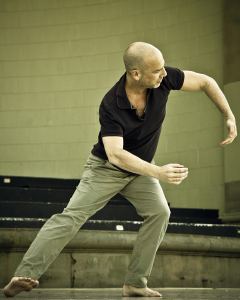IN MARCH, Stephen Pelton Dance Theatre returns to San Francisco after seven years with a new, full-length work Lauda Adrianna. I recently had a FaceTime with Stephen from his home in London. (Full disclosure: Stephen is a close friend and I was the resident playwright with his company from 2006-2011.)
Brian Thorstenson: So it’s been seven years since you showed any work in the Bay Area. But before that, how long were you working here?
Stephen Pelton: I moved to San Francisco at the tail end of 1989 and produced a season of work there pretty much every year until 2009. Hard to believe really that I was so productive! I was also teaching and danced with Della Davidson’s company for four seasons. Ben [Stephen’s husband] and I started spending half of each year in London in 2000.
BT: I know that you have a very full teaching life in the UK and elsewhere in Europe, but this is the first piece you’ve made since you moved to living full-time in London in 2009. What was the impetus for you to make something new after such a long break?
SP: From a practical standpoint, Morag Deyes (artistic director of Dance Base/Edinburgh, the National Centre for Dance in Scotland) challenged me to get back into the studio. “Why aren’t you choreographing?” she asked, and I didn’t really know the answer. This was in 2013, the same year that three important people in my life died: my mad-genius, high school music teacher, George Trautwein; a former dancer with my company, Manfred Schaechtle; and my cousin, Adrienne (the Adrianna of the title). When Morag offered me a week in her studios, I thought: Ok, let’s make a piece where I can contemplate how to process these big, life losses. My roots are Jewish and my aspirations are Buddhist. If I were a church-going Christian in a small, church-going town, perhaps the path of what to do after loved ones die would be laid out for me. But how do I find my way through grief as a choreographer and as a non-practicing Jew tending towards Buddhism?
BT: The new work, Lauda Adrianna, is set to ten of Gavin Bryar’s Laude Cortonese, his re-settings of 12th century religious songs. I know you’ve been obsessed with his music for a long time. How did you come across them? Were they the first pieces of music you thought of for this new piece?

SP: I pretty much buy any new release by Gavin so I heard the laude when they first came out in 2005. I thought Wow! These are amazing – unlike anything I’d heard before. Like much of his music, they are very open, very spacious, very patient. They came to mind immediately when I started thinking about going back into the studio after all those losses. Patience became a big part of the whole project. Could I patiently approach this music? Patiently sit with my grief throughout making this piece? Could the studio be an environment where whatever happens unfolds slowly in a way that requires the utmost patience from me and, ultimately, from an audience? I wanted the piece to be about a ‘spiritual condition.’ And that’s a big word: ‘spiritual,’ an overused word. But I wanted to make the dance about a series of questions rather than about something I already knew, and that’s an odd thing to lead with. The questions did become more specific: How do we face the fact that we must carry on without people? What do we actually do with our longing for someone when they’re gone? What might religious music offer us, even if we’re non-practicing, at times like this?
BT: What’s most surprised you about making this piece?
SP: How universally, how fully, audiences have responded to it and that the religiosity of the music hasn’t distanced people. Ben couldn’t stand the music when I played it at home. He was raised Catholic. But he loved it in the performance at Cottier Cathedral in Glasgow, where the piece premiered in June last year. Also, I use the performers’ focus in a very particular way in the piece: there’s downcast, ground level, eye level, horizon/distance and upward/aspirational, or if you see it that way, heavenward. In French, the word for sky and the word for heaven are the same: le ciel.
BT: Oh, love that!
SP: Right?? It all reminds me of that Rickie Lee Jones lyric from Flying Cowboys.
BT: And we both love her. Which lyric?
SP: From the song “Atlas’ Marker” – Maybe you want another world/One where heaven doesn’t weigh so much. She seems to be asking it as a question, doesn’t she?
BT: I saw some of the early versions of Lauda, but I’m so happy I’m going to be able to see the whole show in March. Why did you want to bring this piece to San Francisco?
SP: When we did the showing in SF in December 2013, we got a great response, including from people who knew my previous work really well. I love Dance Mission and the people who work there and have such sweet memories of doing shows there. Plus I love the SF dancers who have already worked on Lauda—their inspiration and input are a big part of how the piece became what it is. It’s time for them to make it theirs. I’ve been working on this piece for 2 1?2 years. It’s time to come back home and put it out there…
This article appeared in the March 2016 issue of In Dance.


